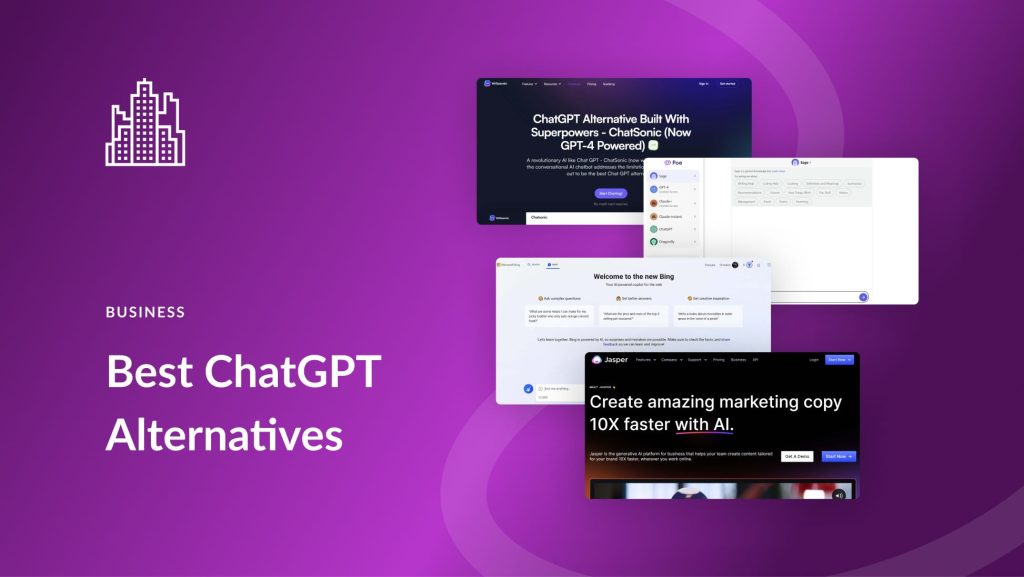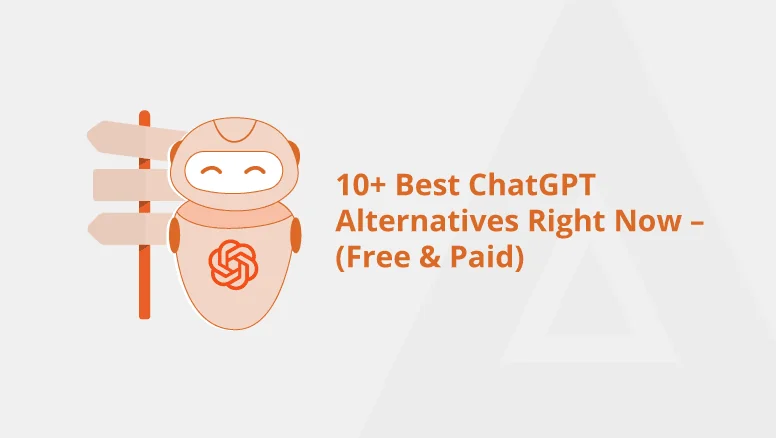ChatGPT Alternatives – Abstract Review
Introduction
In the ever-evolving world of artificial intelligence and natural language processing, chatbots have become an essential tool for businesses and individuals alike. Among these chatbots, ChatGPT has gained significant popularity due to its powerful language capabilities. However, as technology progresses, new alternatives to ChatGPT have emerged, offering diverse features and functionalities. In this article, we will explore the ten best ChatGPT alternatives to use in 2023, each equipped with unique strengths and applications.
ChatGPT Overview
ChatGPT, developed by OpenAI, is an advanced language model based on GPT-3.5 architecture. It has revolutionized the way we interact with chatbots by providing human-like responses and context-aware conversations. ChatGPT’s versatility spans from customer support to creative writing, making it a favorite among users.
Criteria for Evaluation
Before diving into the alternatives, let’s establish the criteria we will use to evaluate each option:
- Language Proficiency: How well does the chatbot understand and respond to user queries?
- Customization: Can the chatbot be tailored to specific industry needs and personalized interactions?
- Integration: How seamlessly does the chatbot integrate with existing platforms and systems?
- AI Capabilities: Does the chatbot offer cutting-edge AI features like sentiment analysis, emotion recognition, and multilingual support?
- Cost and Scalability: What is the pricing structure, and how scalable is the solution for growing businesses?

The 10 Best ChatGPT Alternatives to Use in 2023
1. OpenAI Codex
Overview:
OpenAI Codex is another groundbreaking language model that showcases remarkable capabilities. Developed by OpenAI, Codex excels in converting natural language prompts into usable code. Its deep understanding of programming languages allows developers to interactively collaborate with the model and receive code suggestions, making it a powerful tool for software development tasks.
Features:
- Enables developers to write code with natural language input.
- Provides code completions and can understand syntax errors.
- Offers support for numerous programming languages.
- Python, JavaScript, Go, and more.
2. Rasa
Overview:
Rasa is an open-source conversational AI framework that enables developers to build robust chatbots and virtual assistants. With its natural language processing (NLP) capabilities, Rasa empowers developers to create interactive and context-aware conversational experiences.
Features:
- Supports multi-turn conversations.
- Utilizes machine learning to handle intent recognition and entity extraction.
- Seamless integration with various messaging channels (e.g., Slack, Facebook Messenger).
- Offers customizable dialogue management policies.
3. GPT-3
Overview:
GPT-3, developed by OpenAI, is the predecessor to ChatGPT. Although ChatGPT presents a specialized system for conversational tasks, GPT-3 holds its own as a transformative language model. Its immense size and capabilities allow it to generate coherent and contextually relevant responses across a wide range of topics.
Features:
- Provides a massive language model with 175 billion parameters.
- Offers text generation capabilities.
- Suitable for both creative and practical tasks.
- Has the potential for improved customization with fine-tuning.
4. Dialogflow
Overview:
Dialogflow, a Google Cloud service, empowers developers to create intelligent and dynamic conversational interfaces. With its natural language understanding (NLU) capabilities, Dialogflow enables the design and deployment of chatbots, voice assistants, and various other conversational agents.
Features:
- User-friendly interface for managing chatbot conversations.
- Supports integration with multiple platforms (e.g., websites, mobile apps).
- Offers machine learning-based intent classification and entity extraction.
- Provides built-in small talk and predefined conversational flows.
5. Microsoft Bot Framework
Overview:
Developed by Microsoft, the Bot Framework offers a comprehensive set of tools and services for building AI-powered conversational agents. It supports the development of chatbots across various channels, providing flexibility and scalability.
Features:
- Offers a wide range of SDKs and tools for bot development.
- Supports multiple programming languages (e.g., C#, JavaScript).
- Provides integration with popular communication channels (e.g., Microsoft Teams, Slack).
- Offers a rich ecosystem with pre-built bot templates and modules.
6. Wit.ai
Overview:
Wit.ai, a part of Facebook AI, provides developers with a robust platform for building natural language interfaces. It facilitates the creation of conversational experiences across different channels, empowering developers to integrate AI-driven conversation capabilities seamlessly.
Features:
- Offers powerful natural language processing capabilities.
- Provides customizable intents, entities, and dialogue flows.
- Supports integration with messenger platforms such as Facebook Messenger.
- Supports multi-language conversations.
7. Amazon Lex
Overview:
Amazon Lex is a service provided by Amazon Web Services (AWS) that allows developers to build conversational interfaces with ease. It utilizes automatic speech recognition (ASR) and natural language understanding (NLU) to enable smooth and context-aware interactions between users and chatbots.
Features:
- Offers speech recognition and text-to-speech capabilities.
- Supports the development of voice and text-based chatbots.
- Provides built-in integration with AWS Lambda for custom code execution.
- Enables seamless deployment across various messaging and voice platforms.
8. IBM Watson Assistant
Overview:
IBM Watson Assistant is an AI-powered conversational platform that enables the creation of virtual agents for various industries and use cases. It combines natural language processing, machine learning, and dialog management to deliver contextually aware and personalized conversational experiences.
Features:
- Supports multi-channel deployment, including web, mobile, and messaging platforms.
- Offers intuitive dialog authoring tools.
- Provides AI-powered suggestions for improving conversation flows.
- Allows easy integration with existing backend systems and data sources.
9. Chatfuel
Overview:
Chatfuel is a popular chatbot development platform that simplifies the creation and management of conversational experiences. With its user-friendly interface and powerful AI capabilities, Chatfuel empowers both technical and non-technical users to develop sophisticated chatbots for various purposes.
Features:
- Offers a drag-and-drop chatbot builder.
- Provides integration with major messaging platforms like Facebook Messenger.
- Supports AI-powered conversational flows and user interactions.
- Enables easy customization and integration of plugins and third-party services.
10. BERT
Overview:
BERT (Bidirectional Encoder Representations for Transformers) is a widely renowned language model developed by Google. It’s specifically designed to understand the context and meaning of words in a sentence, making it highly useful for natural language processing and conversational AI tasks.
Features:
- Utilizes transformer-based architecture for language representation.
- Supports a wide range of natural language understanding tasks.
- Effective in question answering, sentiment analysis, named entity recognition, etc.
- Enables fine-tuning for domain-specific applications.
Conclusion
In conclusion, while ChatGPT remains a formidable chatbot, the dynamic landscape of AI brings forth an array of alternatives that cater to diverse business needs. Each alternative excels in specific aspects, be it language proficiency, AI capabilities, or industry-specific applications. It’s essential for businesses to assess their requirements and choose an alternative that aligns with their objectives and customer expectations.
FAQs
- Are these alternatives capable of handling large-scale interactions? Yes, several of the mentioned alternatives are designed to handle high volumes of interactions and can be scaled as per the business needs.
- Do these chatbots require technical expertise for deployment? While some alternatives offer user-friendly interfaces, a basic understanding of AI and chatbot deployment is beneficial for customization.
- Can I integrate these chatbots with my existing CRM systems? Many of the alternatives mentioned here offer seamless integration with popular CRM systems, streamlining customer data management.
- Do these chatbots support multiple languages? Yes, a majority of these alternatives provide multilingual support, catering to global audiences effectively.
- Are these alternatives cost-effective for startups? Yes, some alternatives are specifically designed to be cost-effective, making them suitable for startups and small businesses.
Click Here to read about top 10 features of Adobe Acrobat.

